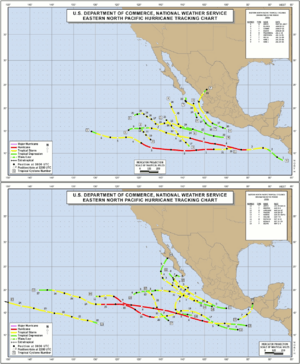1970 Pacific hurricane season facts for kids
 |
|
| Season summary map | |
| First storm formed | May 30, 1970 |
|---|---|
| Last storm dissipated | November 8, 1970 |
| Strongest storm | Lorraine - 963 mb, Patricia - 95 knots – |
| 19 | |
| Total fatalities | 0 direct, 22 indirect |
| Total damage | $1 million (1970 USD) (indirect damages only, minimal direct damage) |
| seasons 1950-1969, 1969, 1970, 1971, 1972 |
|
The 1970 Pacific hurricane season was a period when tropical storms and hurricanes formed in the eastern and central Pacific Ocean. It officially began on May 15, 1970, for the eastern Pacific. For the central Pacific, it started on June 1, 1970. The season ended for both areas on November 30, 1970. These dates are set to cover most of the time when these powerful storms usually happen.
This season had more storms than average. There were twenty-one tropical cyclones in total. Out of these, eighteen grew strong enough to be called tropical storms. Four of these storms became hurricanes. However, none of them became a "major hurricane," which is the strongest type. In the central Pacific, one hurricane and one tropical depression formed. One of the depressions even crossed the International Date Line and became a typhoon.
Contents
Understanding the 1970 Pacific Hurricane Season
A hurricane season is a specific time of year when tropical cyclones are most likely to form. These powerful weather systems develop over warm ocean waters. They bring strong winds, heavy rain, and sometimes storm surges.
What is a Tropical Cyclone?
A tropical cyclone is a rotating storm system. It forms over tropical or subtropical waters. These storms get their energy from the evaporation of water from the ocean. As the warm, moist air rises, it cools and forms clouds. This process releases heat, which makes the storm stronger.
Different Kinds of Storms
Tropical cyclones have different names based on their strength.
- Tropical Depression: This is the weakest type. It has organized clouds and thunderstorms. Its winds are less than 39 miles per hour (63 km/h).
- Tropical Storm: When a tropical depression gets stronger, it becomes a tropical storm. Its winds are between 39 and 73 miles per hour (63–118 km/h). At this stage, the storm is given a name.
- Hurricane: A hurricane is a very strong tropical cyclone. Its winds are 74 miles per hour (119 km/h) or more. Hurricanes are categorized by their wind speed.
How Storms are Named
Once a tropical cyclone reaches tropical storm strength, it gets a name. This helps people track and talk about the storm. Names are chosen from a list that repeats every few years. For example, the storms in 1970 had names like Lorraine and Patricia.
The Pacific Ocean Basins
The Pacific Ocean is very large. For tracking hurricanes, it's divided into two main parts:
- Eastern Pacific: This area is east of 140°W longitude. Most of the storms in the 1970 season formed here.
- Central Pacific: This area is between 140°W and the International Date Line (180° longitude). Fewer storms usually form here.
Crossing the Date Line
Sometimes, a storm can move from the central Pacific into the western Pacific. When it crosses the International Date Line, it changes its name. In the western Pacific, tropical cyclones are called "typhoons." One storm in 1970 did this.
The 1970 Season in Numbers
The 1970 Pacific hurricane season was quite active. It had more storms than what is typical for this region.
Storm Activity Summary
- Total Tropical Cyclones: There were 21 tropical cyclones identified. This includes depressions, tropical storms, and hurricanes.
- Tropical Storms: 18 of these cyclones became strong enough to be named tropical storms.
- Hurricanes: 4 of the storms reached hurricane strength. This means their winds were very powerful.
- Major Hurricanes: None of the hurricanes in 1970 reached "major hurricane" status. A major hurricane has winds of 111 mph (178 km/h) or higher.
Impact and Damages
The 1970 season caused some damage, but it was mostly indirect. This means the damage wasn't directly from the wind or rain of the storms. For example, heavy rains from a storm might cause a landslide later. There was very little direct damage. Sadly, there were 22 indirect deaths linked to the storms. No direct deaths were reported.

